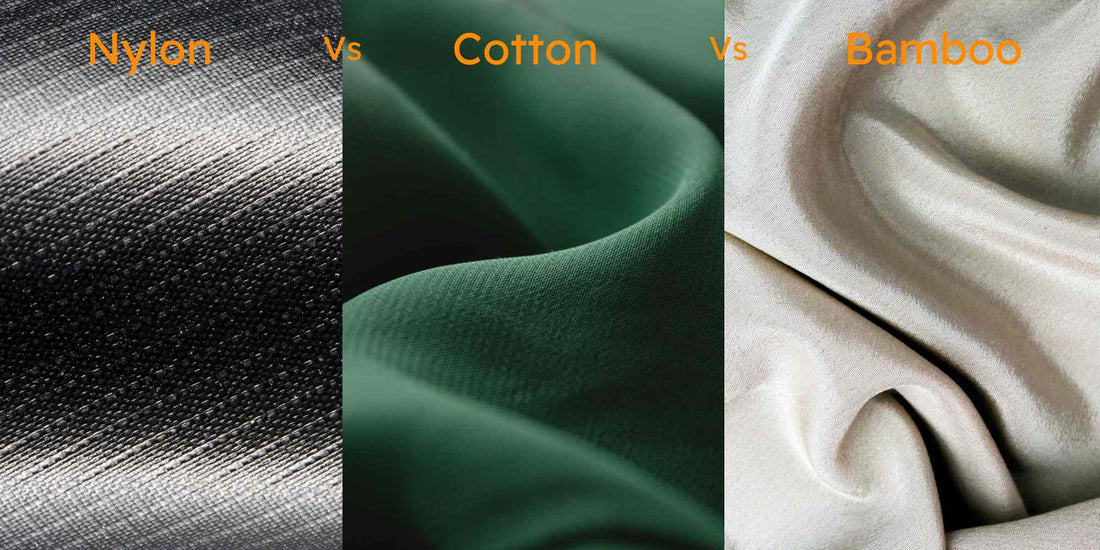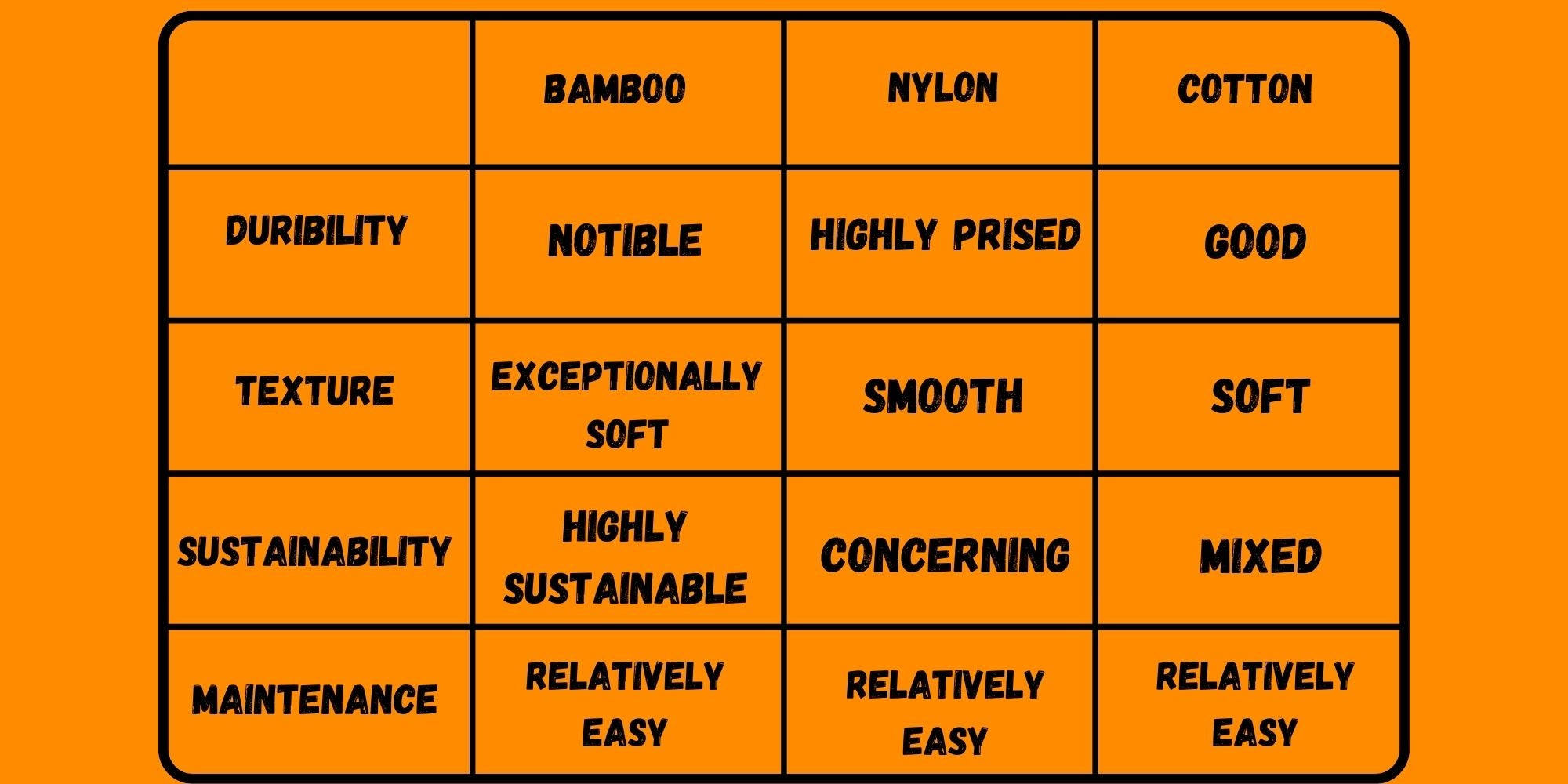
Nylon Underwear vs Cotton vs Bamboo Underwear
Choosing the perfect underwear often comes down to comparing nylon vs cotton vs bamboo. Each offers unique benefits, complicating the decision. To pick the right one—based on comfort, durability, or eco-friendliness—it's crucial to understand their differences. Let's explore these materials to determine the best option.
What is Nylon Underwear?
Manufacturers make nylon underwear from a synthetic polymer, a type of plastic derived from petroleum, introduced in the 1930s. Its strength, elasticity, and resistance to mildew and moths quickly made it popular. It's known for its smooth texture, providing a sleek fit that glides easily under clothes, making it a favorite for those seeking a seamless look. However, nylon is not as breathable as natural fabrics, which can sometimes lead to discomfort in hot or humid conditions. Additionally, because manufacturers derive nylon from petroleum, it does not represent the most environmentally friendly option available.
Characteristics of Nylon Underwear:
- Durability: Nylon underwear is highly praised for its exceptional durability and resilience. Furthermore, it retains its shape and elasticity even after extensive wear and multiple washes, effectively resisting pilling and stretching. Consequently, this synthetic fabric's strength makes it a long-lasting choice, ideal for those seeking garments that won't easily wear out or degrade.
- Texture: The texture of nylon is smooth and sleek, offering a close fit that feels like a second skin.Its design ensures easy gliding under clothes, reducing friction and preventing bunching, making it popular for activewear and seamless styles. Yet, being synthetic, it may not breathe as well as natural fabrics, a concern in warmer climates.
- Sustainability: Research shows that Nylon's sustainability is a concern due to its synthetic origin, derived from petroleum, a non-renewable resource. The production process is energy-intensive and contributes to pollution. Furthermore, nylon is not biodegradable, posing challenges for disposal and environmental impact over the long term. Efforts to recycle nylon and improve manufacturing efficiency are ongoing, but the material's ecological footprint remains a significant consideration.
- Maintenance: For nylon underwear, initially, machine wash in warm water with a gentle detergent to maintain its elasticity and appearance. Subsequently, air drying is recommended to prevent heat damage from the dryer; if you find it necessary to use a dryer, opt for a low heat setting. Moreover, avoid chlorine bleach to protect the nylon fibers. Diligently following these care practices will maintain your nylon underwear's durability and shape, ensuring comfort and longevity.
What is Cotton Underwear?
Manufacturers craft cotton underwear from natural cotton fibers, making it one of the most traditional and widely used materials for undergarments. Cotton is highly absorbent, efficiently soaking up moisture to keep the wearer dry and comfortable. However, this absorbency can also be a drawback, as cotton underwear may take longer to dry once wet, potentially leading to discomfort in sweaty situations or damp weather.
Characteristics of Cotton Underwear:
- Durability: Cotton underwear is known for its good durability, capable of withstanding regular wear and numerous washes. While it generally maintains its comfort over time, cotton can be prone to shrinking and wear if not cared for properly. It's important to follow care instructions to preserve the longevity of cotton garments.
- Texture: The texture of cotton fabric is naturally soft and breathable, making it incredibly comfortable for everyday wear. Its ability to absorb moisture contributes to its comfort, though it may not dry as quickly as synthetic fabrics
- Sustainability: Cotton's sustainability is mixed. On one hand, it is a natural, biodegradable fiber, which is a positive aspect for the environment. However, conventional cotton farming is resource-intensive, requiring significant amounts of water and pesticides, which can harm the environment.
- Maintenance: Cotton underwear should be washed in warm water for whites and cold water for colors with a mild detergent, to preserve fabric integrity and color. Tumble dry on a low heat setting to minimize shrinkage, or air dry for optimal fabric care. Use non-chlorine bleach for stains to avoid damaging the material. These maintenance tips will help your cotton underwear retain its comfort and durability over time.
What is Bamboo Underwear?
Bamboo underwear is made from bamboo fibers, which are derived from the bamboo plant. This material has gained popularity for its eco-friendly qualities and exceptional comfort. The fabric produced from bamboo is soft, with a texture comparable to that of silk or cashmere, providing a luxurious feel. It's also highly breathable and moisture-wicking, offering superior comfort by keeping the wearer dry and cool.
Characteristics of Bamboo Underwear:
- Durability: Bamboo underwear is notably durable, able to endure frequent wear and washes without losing its shape or quality. Its natural long fibers contribute to a strong fabric that resists pilling and stretching, offering longevity and reducing the need for frequent replacements.
- Texture: The texture of bamboo fabric is exceptionally soft, comparable to silk or cashmere, making it extremely comfortable against the skin. This smoothness, combined with hypoallergenic properties, makes bamboo underwear especially suited for those with sensitive skin. Its breathability and moisture-wicking capabilities further enhance wearer comfort, keeping you dry and comfortable.
- Sustainability: According to research Bamboo is a highly sustainable resource, growing rapidly with minimal water, no pesticides, and enhancing air quality by absorbing carbon dioxide. The eco-friendliness extends to bamboo fabric, especially when produced through environmentally conscious processes. This makes bamboo underwear a choice that supports not only personal comfort but also planetary health.
-
Maintenance: To maintain bamboo underwear, wash it in cold or warm water with gentle, eco-friendly detergent and air dry to preserve its softness and durability. If using a dryer, select the lowest heat setting. Avoid chlorine bleach, opting for mild, eco-friendly alternatives for stains. Following these simple steps will keep your bamboo underwear in great condition, ensuring lasting comfort and sustainability.

In the comparison between bamboo, cotton, and nylon underwear, bamboo underwear clearly stands out as the superior choice. Firstly, it combines durability, unparalleled comfort, and impressive environmental sustainability. Additionally, bamboo's softness rivals that of silk or cashmere, providing exceptional comfort and making it suitable for sensitive skin with its hypoallergenic properties. Furthermore, its breathability and moisture-wicking capabilities ensure wearer comfort in any condition.
Environmentally, bamboo stands out for its sustainability, needing less water and no pesticides to grow, while also absorbing more carbon dioxide.
In conclusion, for those prioritizing comfort, longevity, and environmental responsibility, bamboo underwear emerges as the best option, offering a blend of all these qualities without significant compromises.









